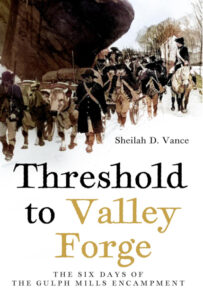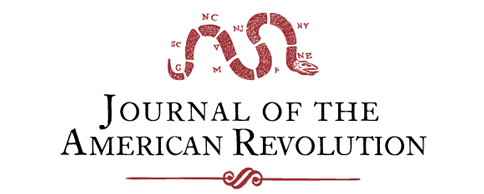BOOK REVIEW: Threshold to Valley Forge: The Six Days of the Gulph Mills Encampment by Sheilah D. Vance (Havertown, PA: Brookline Books, 2025) $24.95 Paperback.
As the crow flies, the region west of Matson’s Ford and known as “The Gulph” loomed a mere dozen miles northwest of Philadelphia. The nearly weeklong encampment of George Washington and the Continental army at the Gulph in the middle of December linked the Philadelphia Campaign of 1777 with the 1777–1778 winter/spring encampment at Valley Forge. Due to this “bridge” between two more famous events, the encampment is usually relegated to mere sentences or no more than a few paragraphs in Revolutionary War historiography.
 Unlike the six months at Valley Forge, the six days at The Gulph are devoid of strong tradition. Primary sources generated from and about the encampment are understandably sparse in comparison to Valley Forge. For example, nobody knows where individual brigades tented; in fact, no one knows exactly where George Washington headquartered (three homes existed as candidates for his quarters).
Unlike the six months at Valley Forge, the six days at The Gulph are devoid of strong tradition. Primary sources generated from and about the encampment are understandably sparse in comparison to Valley Forge. For example, nobody knows where individual brigades tented; in fact, no one knows exactly where George Washington headquartered (three homes existed as candidates for his quarters).
Sheilah D. Vance attempts to correct this oversight in the literature with Threshold to Valley Forge: The Six Days of the Gulph Mills Encampment. This reviewer recommends this book for filling the void and doing so with a trove of wonderful excerpts and images. The primary accounts are numerous and specific to the period while the publisher presents the images in a welcome array of modern and period maps, old photographs and drawings, as well as numerous visual displays of the primary sources: official returns, original letters, advertisements, proclamations, and newspaper excerpts. This presentation is unique and appealing. Together, the sources and the visuals elevate Threshold to Valley Forge to a welcome addition to the Revolutionary War literature.
The author presents her narrative as five main themes of significant events occurring simultaneously during the encampment. This includes the British occupation of Philadelphia, George Washington’s plans for the winter, activities of the Continental Congress and Pennsylvania’s legislature, and negotiations of American diplomats with French officials to recognize and support the United States. Each chapter is segmented by day, including three chapters as a prelude to the encampment. The author zooms in to describe the machinations of the army that encamped at The Gulph, but also pans out to include the Crown forces, other regions in the country––particularly the activities of the Continental Congress and the Board of War in York––and even includes overseas correspondences and activities.
This focus on the date produces a mixed result. On the positive side it is an interesting method to buck traditional presentation of history. It produces revealing outcomes, such as renowned British scientist Joseph Priestly indicating how “anxious” and “melancholy” he felt about the “unnatural war” against America in a December 13 letter he wrote to Benjamin Franklin. It also benefits the reader to know the machinations in Europe and with the Continental Congress during each day of the Gulph encampment.
This approach is beset with drawbacks. The most important is confusion to the reader. After detailing the December 11 action at Matson’s Ford in Chapter 3 (appropriately titled: “The Battle of Matson’s Ford, December 11”), Ms. Vance launches Chapter 4 (“The Army is on the Move Again, December 12”) with a detailed letter from Baron de Kalb detailing the December Matson’s Ford action that occurred the day before. She calls back Matson’s Ford and the preceding Battle of Whitemarsh several times over the subsequent three chapters, simply because a soldier wrote a letter describing it on the date highlighted in the chapter. This includes an entire page about the December 11 engagement in a chapter dedicated to December 14. Her readers would have been far better swerved had she kept all descriptions of Whitemarsh in Chapter 2 when the action took place, and Matson’s Ford to Chapter 3. De Kalb’s letter, in particular, seems strikingly out of place, as does a rather innocuous exchange of letters between George Washington and the head of the Eastern Department, which consumes two pages of narrative and has absolutely nothing to do with the Gulph encampment.
There are occasions where the author mishandles the facts she presents. She speculates, “Whether Washington thought that he would establish winter quarters at Gulph Mills is unknown.” She even begins a paragraph in her December 13 chapter with the following: “Washington immediately sought to get his army settled” (page 66). Yet later in the same paragraph she cites from general orders that day that the soldiers were to be prepared to march away from the region at 4:00 A.M. on December 14. Two days later, the army and baggage were again ordered to move out the following morning. The reason for cancellation of both of these departures are unknown, but it defies the author’s assertions by demonstrating that there was no desire for Washington to settle into the Gulph for a winter encampment.
When did Washington decide to move his army to Valley Forge? Ms. Vance marks December 17 at the Gulph as the day he announced in general orders that the army would move into winter quarters, location nearby but undefined. True enough; however, she also correctly notes that a regimental officer had identified in his December 15 diary entry that the destination of winter quarters was “eight miles up the Schuylkill,” fairly locating Valley Forge without naming it. His entry was not the result of a wild guess. One of Washington’s aides on the same date (December 15) revealed that Washington would likely announce the location that day. These two sources are strong evidence that December 15 was the day Washington chose Valley Forge as the site for winter quarters and not December 17 when he officially announced it. Two days difference is hardly an earth-shattering discrepancy, but if a date at the Gulph is going to be called a “pivotal” day because of this decision, the earlier date should have been highlighted over the later one.
The author would have been better served by more careful historical editing. While it’s acceptable to include the tradition that Washington and Lafayette stopped at Old Swede’s Church on their way to the Gulph, an effort should have been made to refute the notion that “General John Paul Jones” was with them. In three different chapters Ms. Vance details four accounts about skirmishes that occurred during the Gulph Mills encampment. But she never realized she was describing the exact same December 14 event from four different points of view. Philadelphia is about half the forty-four miles claimed by the author as the distance from the Brandywine battlefield. John Clark was a major, not a major general. The origin of the locale known as “Rebel Hill” is described in two different ways in two different places in the book, leaving the reader confused as to which one to accept. There are a few proofreading misses such as citing the battle cry, “Remember Paoli,” twice on the same page and allowing “arrival of a French shop with supplies for the troops” to be published without the necessary edit. Fortunately, these mistakes are few and far between and do not detract from the overall history.
Like so many past Philadelphia Campaign authors, no fewer than five times does Ms. Vance put the strength of the Continental army at 11,000. It’s the number of troops she presents at Brandywine, and then before and after Germantown. After acquiring six more brigades from the Northern and Eastern Departments the author erroneously places American numerical strength during the Gulph encampment again at 11,000. In the past, it would be difficult to fault her since so many others have been fixated on “11,000” all the way to Valley Forge, but a three-year-old published analysis (co-authored by this reviewer) nearly doubles this number. She provides no explanation for how the weekly army returns that were completed the week before and after this encampment––both mentioned by her––flagrantly conflict with her numbers.
Ms. Vance presented data that should have elevated the true numbers within the Gulph encampment into something much more extraordinary than what has been presented in the past. The author publishes for the first time the December 15 weekly return of one of the seventeen infantry brigades there (Varnum’s), indicating it consisted of 1,464 soldiers during the Gulph encampment (she included 380 soldiers clearly tallied as absent and excluded 143 officers and non-commissioned personnel marked as present; the brigade totaled 1,327 present). This return by itself is enough to disprove the 11,000 figure, because if it was accurate that George Washington marched only 11,000 into the Gulph on December 13, then each of the remaining sixteen brigades of the army must have averaged only 600 officers and men––less than half the strength of Varnum’s. The Varnum’s brigade return and the entire army returns bookending the Gulph encampment indicate that 21,000 Continentals (totaled from seventeen infantry brigades, artillery and dragoons) encamped at The Gulph, rivaling New York City as the second largest population center in the country and standing out as perhaps the largest single-location military force on the face of the earth for those six days in December 1777. An additional 3,500 militia were in the region as well.
The reason to highlight this is much greater than a quibble. The commissary and quartermaster departments simultaneously began a collapse during the final days of the Gulph encampment that would exacerbate to a catastrophe a few days later at Valley Forge. The deputy commissary of issues complained while at the Gulph of the scarcity of provisions and wagons to supply the Continentals, warning that if not immediately addressed, “the army will not be able to exist one week longer.”[1] It is surprising that this history of the Gulph Mills encampment excluded this prelude to disaster, but it can only be appreciated when the true numerical strength is presented.
The final chapter of the book was an enlightening addition to the history of the Gulph. These ten pages discuss the role of the Gulph as an outpost during the army’s sojourn at Valley Forge during the winter and spring of 1778, history rarely captured in Revolutionary War literature.
It is apparent that the author discovered that there is not enough material or interest to dedicate a book-length treatment strictly to the six-day encampment at the Gulph. For this reason, she converted this to a narrative of December 10-19, 1777, in the United States and abroad, with an emphasis on Washington and his army as it moved from Whitemarsh across the Schuylkill, encamped on the Conshohocken Hills surrounding Gulph Mill, and then moved on to Valley Forge. Although a few hiccups interrupted her portrayal of this ten-day history, the result is an admirable presentation of an important but often overlooked period of the Revolutionary War.
PLEASE CONSIDER PURCHASING THIS BOOK FROM AMAZON IN PAPERBACK OR KINDLE.
(As an Amazon Associate, JAR earns from qualifying purchases. This helps toward providing our content free of charge.)
[1] Thomas Jones to Thomas Wharton, December 19, 1777, Pennsylvania Archives, series 1 (6), 107-108.





Recent Articles
The Deadliest Seconds of the War
Entangled Alliances: Racialized Freedom and Atlantic Diplomacy During the American Revolution
Videau’s Bridge: An American Disaster After Yorktown
Recent Comments
"A Curious Agreement Among..."
Mr. Ness, I would love to have a copy of that list....
"Unraveling the Mystery of..."
This is superbly researched and I think you perfectly settled the matter....
"The New Dominion: Virginia’s..."
Thanks, Eric! There's more to come on this. Three generations of my...